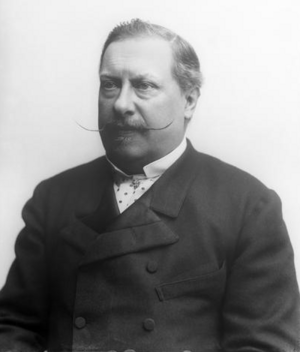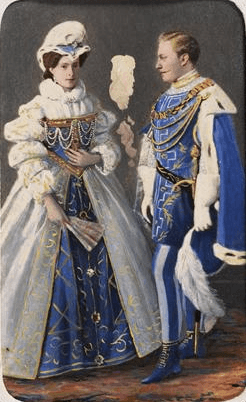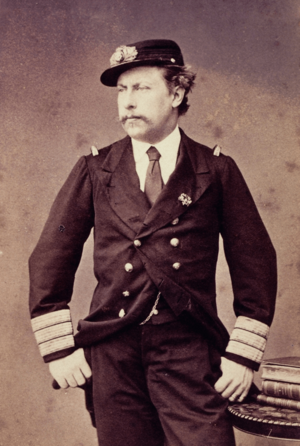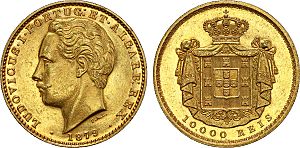Luís I of Portugal facts for kids
Quick facts for kids Luís I |
|
|---|---|

Photograph by Augusto Bobone c. 1880s
|
|
| King of Portugal | |
| Reign | 11 November 1861 – 19 October 1889 |
| Acclamation | 22 December 1861 |
| Predecessor | Pedro V |
| Successor | Carlos I |
| Prime Ministers |
See list
The Duke of Loulé
The Marquis of Sá da Bandeira Joaquim António de Aguiar The Duke of Ávila and Bolama The Duke of Saldanha Fontes Pereira de Melo Anselmo José Braamcamp António Rodrigues Sampaio José Luciano de Castro |
| Born | Luís Filipe Maria Fernando Pedro de Alcântara António Miguel Rafael Gabriel Gonzaga Xavier Francisco de Assis João Augusto Júlio Valfando de Bragança-Saxe-Coburgo e Gota 31 October 1838 Necessidades Palace, Lisbon, Portugal |
| Died | 19 October 1889 (aged 50) Citadel Palace, Cascais, Portugal |
| Burial | Pantheon of the Braganzas |
| Spouse |
Maria Pia of Savoy
(m. 1862) |
| Issue |
|
| House | Braganza |
| Father | Ferdinand of Saxe-Coburg and Gotha |
| Mother | Maria II of Portugal |
| Religion | Roman Catholicism |
| Signature | |
Dom Luís I (Portuguese pronunciation: [luˈiʃ]; Louis; 31 October 1838 – 19 October 1889), known as the Popular (Portuguese: o Popular) was King of Portugal from 1861 to 1889. The second son of Queen Maria II and her consort, King Ferdinand, he acceded to the throne upon the death of his elder brother King Pedro V. He was a member of the ruling House of Braganza
Reign
Luís was a cultured man who wrote vernacular poetry, but had no distinguishing gifts in the politics into which he was thrust by the death of his older brother Pedro V in 1861. Luís's domestic reign was a series of transitional governments called Rotativism formed at various times by the Progressistas (Liberals) and the Regeneradores (Conservatives), the party generally favoured by King Luís, who secured their long term in office after 1881. Despite a flirtation with the Spanish succession prior to the Franco-Prussian War of 1870–71, Luís's reign was otherwise one of domestic stagnation as Portugal fell ever farther behind the nations of western Europe in terms of public education, political stability, technological progress and economic prosperity. In colonial affairs, Delagoa Bay was confirmed as a Portuguese possession in 1875, whilst Belgian activities in the Congo and the 1890 British Ultimatum prevented the Portuguese from colonizing modern-day Botswana in order to establish a link between Portuguese Angola and Portuguese Mozambique at the peak of the Scramble for Africa.
Personal interests
Luís was also very keen with literature, not only with books in Portuguese but also in English. He was the first to bring fully translated Shakespearean works to Portugal, such as The Merchant of Venice, Richard III and Othello, the Moor of Venice. His best-known work in Portugal was his translation of Hamlet.
Marriages and descendants
In June 1862, Luís asked Archduchess Maria Theresa of Austria (1845–1927), a daughter of Archduke Albert, Duke of Teschen and Princess Hildegard of Bavaria, to marry him in a letter sent to her father. It was urgent for him to get married as his older brother, King Pedro V, had died in November 1861, without issue and two of his younger brothers, João and Fernando, followed him shortly after, which left the Braganza dynasty almost without heirs. Luís had already selected a number of brides including Princess Marie of Hohenzollern-Sigmaringen (1845-1912), sister of his late sister-in-law Stephanie, Duchess Sophie Charlotte in Bavaria (1847-1897), Princess Maria Pia of Savoy (1847-1911) and also considered some Austrian archduchesses, Maria Theresa being one of them, but didn't know which one to choose. So he sent letters to his cousin, Queen Victoria, and his great-uncle, King Leopold I of Belgium, to ask for their advice. Both agreed that the best choice was Maria Theresa. Thus, King Luís sent his letter. However, his wish was not fulfilled as her father, Archduke Albert, thought she was too young at the time (she was one month away from turning 17) and needed to finish her education. Two weeks after, Luís asked for the hand of Princess Maria Pia of Savoy and, this time, was accepted, even though Maria Pia, born in 1847, was even younger than Maria Theresa.
Luís married Maria Pia, the daughter of Victor Emmanuel II of Italy and Maria Adelaide of Austria, on 6 October 1862. They both had a deep love at first, but Luis's countless mistresses led Maria Pia to depression. Together they had two sons who survived childhood.
- Dom Carlos, Prince Royal of Portugal (28 September 1863 – 1 February 1908), successor as King Carlos I; murdered by the Carbonária.
- Dom Afonso, Prince Royal of Portugal (31 July 1865 – 21 February 1920), Infante of Portugal, Duke of Porto, Viceroy of India, and after 1908 Prince Royal.
- Miscarriage (1866)
The King also fathered one illegitimate son, also named Carlos Augusto, who was born in 1874 in Lisbon.
Honours
He received the following orders:
 Austria: Grand Cross of the Royal Hungarian Order of St. Stephen, 1854
Austria: Grand Cross of the Royal Hungarian Order of St. Stephen, 1854 Baden:
Baden:
- Knight of the House Order of Fidelity, 1885
- Knight of the Order of Berthold the First, 1885
 Bavaria: Knight of St. Hubert, 1867
Bavaria: Knight of St. Hubert, 1867 Belgium:
Belgium:
 Order of Leoopold (Grand Cordon) (Belgium) , 9 July 1854
Order of Leoopold (Grand Cordon) (Belgium) , 9 July 1854
 Brazil:
Brazil:
 National Order of the Southern Cross (Grand Collar - Grande Colar) (Brazil) , 1861
National Order of the Southern Cross (Grand Collar - Grande Colar) (Brazil) , 1861- Grand Cross of the Rose, with Collar
- Grand Cross of the Order of Pedro I, with Collar
 Denmark: Knight of the Elephant, 18 April 1864
Denmark: Knight of the Elephant, 18 April 1864

 Ernestine duchies: Grand Cross of the Saxe-Ernestine House Order, 1854
Ernestine duchies: Grand Cross of the Saxe-Ernestine House Order, 1854 France:
France:
 Légion d'honneur (Grand Cross - Grand-croix) (France)
Légion d'honneur (Grand Cross - Grand-croix) (France)- Military Medal
 Greece: Grand Cross of the Redeemer
Greece: Grand Cross of the Redeemer Hanover:
Hanover:
- Knight of St. George, 1861
- Grand Cross of the Royal Guelphic Order
 Hawaii: Grand Cross of the Order of Kamehameha I, 19 August 1881
Hawaii: Grand Cross of the Order of Kamehameha I, 19 August 1881 Hesse and by Rhine: Grand Cross of the Ludwig Order, 7 December 1865
Hesse and by Rhine: Grand Cross of the Ludwig Order, 7 December 1865 Japan: Grand Cordon of the Order of the Chrysanthemum, 20 April 1883
Japan: Grand Cordon of the Order of the Chrysanthemum, 20 April 1883 Liberia: Grand Cross of the Order of African Redemption
Liberia: Grand Cross of the Order of African Redemption Mecklenburg: Grand Cross of the Wendish Crown, with Crown in Ore and Collar
Mecklenburg: Grand Cross of the Wendish Crown, with Crown in Ore and Collar Mexico: Grand Cross of the Mexican Eagle, with Collar, 1865
Mexico: Grand Cross of the Mexican Eagle, with Collar, 1865 Monaco: Grand Cross of St. Charles
Monaco: Grand Cross of St. Charles Netherlands: Grand Cross of the Netherlands Lion
Netherlands: Grand Cross of the Netherlands Lion Ottoman Empire:
Ottoman Empire:  Order of the Medjidie (Class I: Gold) (Ottoman Empire) , 1st Class in Diamonds
Order of the Medjidie (Class I: Gold) (Ottoman Empire) , 1st Class in Diamonds Tunisia: Grand Cordon of the Order of Glory, in Diamonds
Tunisia: Grand Cordon of the Order of Glory, in Diamonds Prussia: Knight of the Black Eagle, 24 July 1854; with Collar, 1862
Prussia: Knight of the Black Eagle, 24 July 1854; with Collar, 1862 Romania:
Romania:
- Grand Cross of the Crown of Romania
- Grand Cross of the Star of Romania
 Russia:
Russia:
- Knight of St. Andrew, with Collar
- Knight of St. Alexander Nevsky
- Knight of the White Eagle
- Knight of St. Anna, 1st Class
 San Marino: Grand Cross of San Marino
San Marino: Grand Cross of San Marino Sardinia:
Sardinia:
- Knight of the Annunciation, 15 July 1855
- Grand Cross of Saints Maurice and Lazarus, 15 July 1855
 Sovereign Military Order of Malta: Bailiff Grand Cross of Honour and Devotion
Sovereign Military Order of Malta: Bailiff Grand Cross of Honour and Devotion Saxe-Weimar-Eisenach: Grand Cross of the White Falcon, 1 August 1854
Saxe-Weimar-Eisenach: Grand Cross of the White Falcon, 1 August 1854 Saxony: Knight of the Rue Crown, 1854
Saxony: Knight of the Rue Crown, 1854 Serbia: Grand Cross of the Cross of Takovo
Serbia: Grand Cross of the Cross of Takovo Siam: Knight of the Nine Gems
Siam: Knight of the Nine Gems Spain:
Spain:
- Knight of the Golden Fleece, 28 November 1861
- Grand Cross of Naval Merit, with Red Decoration, 1877
- Grand Cross of the Military Order of St. Ferdinand
- Grand Cross of Military Merit

 Sweden-Norway:
Sweden-Norway:
- Knight of the Seraphim, 27 November 1861
- Grand Cross of St. Olav, 28 December 1872
 United Kingdom: Stranger Knight of the Garter, 17 June 1865
United Kingdom: Stranger Knight of the Garter, 17 June 1865 Württemberg: Grand Cross of the Württemberg Crown, 1865
Württemberg: Grand Cross of the Württemberg Crown, 1865
See also
 In Spanish: Luis I de Portugal para niños
In Spanish: Luis I de Portugal para niños




